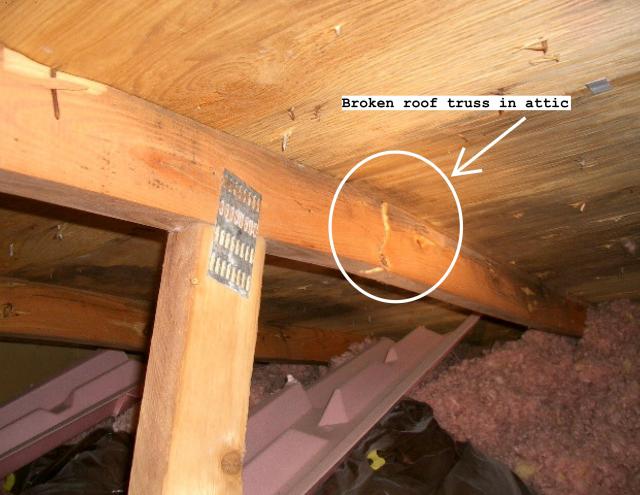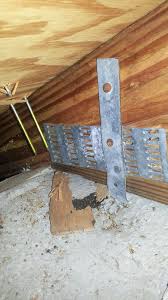This is a picture of a truss located in the attic of a house.A truss is framework consisting of rafters, posts, and struts which supports the roof of the house. In this picture a cracked truss is shown. This cracked truss is a defect.

This is a picture of a truss located in the attic of a house.A truss is framework consisting of rafters, posts, and struts which supports the roof of the house. In this picture a cracked truss is shown. This cracked truss is a defect.

I read on the article about wind mitigation. wind mitigations benefit not only the homeowner but the insurers and government as well. In some states homeowners get lowered premiums for having a wind mitigation done.Wind mitigations help protect the home from damage
Picture shows not only the metal plate attaching truss to outside weight bearing wall, but also the single wrap that extends from the bead outside wall over the existing truss and anchoring onto the opposing weight bearing wall structure creating a stable anchoring system.
Additional waterproofing underlayment is need on many areas including sloped roofs between 2/12 and 4/12, around roof penetrations, around valleys, hops and ridges, roof rakes, and roof eaves. If the SWR is applied under the strand board it will achieve a much better seal to keep out moisture and rain.
Shown is a single strap with only one nail attached. The strap is not properly installed and secured per standards. The strap appears to extend under the insulation, however upon further inspection by removing the insulation around the base of the strap we found that the strap was not attached to the wall structure. Never assume that all straps are attached when hidden by insulation.

The Wind Mitigation article covers the basics of wind storms and wind damage caused during storms to homes or structures. The article outlines the general facts surrounding wind damage in Florida and spells out the benefits of having a wind mitigation performed on homes within Florida. Additionally this article covers the wind mitigation techniques to perform on the inspection form during the inspection.
Attached is a photo of composite slate tiles that are 11 years of age and were damaged by hurricane Irma. The roof suffered significant damage which displays that composite tiles could not handle hurricane force winds. Metal roofs sustained the least amount of damaged.
This photo is of the back side of the roof to wall attachment. It has one nail. The front side of this attachment has two nails and has less than a 1/2" gap. This attachment qualifies as “C” single wrap in item 4 of report.

In the article “Inspecting Aluminum Wiring” it discusses the use of Alumiconn connectors for a solution to defects in aluminum wiring. Alumiconns are not approved by the CPSC, larger than approved crimps and are often improperly installed creating a hazard.
While reading the article on wind mitigations, i learned the need for wind mitigations for insurance companies. I learned that a well built weatherproof house can result in a lower insurance rate than a house not built as structurally sound.
This picture shows the side of a home with a hip roof and a porch overhang. The home has two gables on it large enough to exceed 10% of the homes perimeter. So the home would be considered a non-hip roof shape.
Internal pressures are caused by natural permeability (leakage) in a building and/or when wind enters the building through an opening caused by a window or door failure due to pressure or debris impact. Internal pressures are considered in the determination of wind pressures and are added to (or subtracted from) the external pressures.
There are a number of building characteristics that influence the losses experienced in hurricanes. The most important and frequently overlooked element is the roof covering. High wind-resistant roof coverings are extremely important in reducing building damage.Holding up the roof covering is the roof sheathing.
Utilizing the Zircon MT6 scanner I was able to verify six inch spacing of 8d nails along the truss. I examined two other trusses as well and found the spacing to be uniform with no missed nails. I confirmed the size of the nail by using the scanner to measure how far the nail penetrated into the truss and adding the thickness of the roof sheathing.
I read the Wind Mitigation article. I had no idea that premiums were hiked almost 45% to cover wind damage. I recently moved to Florida and experienced my first hurricane last year. I live in a newly built home that has full discount for wind mitigation and I now know why. Inspecting other homes without wind mitigation features makes me nervous for the homeowner because I know that the roof is going to fail at some point.
The component picture is that of a garage door that is fully operational and aesthetically pleasing. However upon further review of this door is not hurricane rated. To meet today’s standards a garage door must withstand rapid cyclic pressure and must resist large missile impacts. It would be a wise choice to have a new garage door installed with the appropriate features which would also qualify for a possible insurance premium reduction.
Concrete is a very important building material that has been made from many different materials. The early users of concrete used materials from their landscape mixed together to form a cement that is one of the ingredients of concrete. Mixed with other natural materials chemical reactions take place to create a strong bonding aggregate that has been used in the BC period through current day.
As I learn about Wind Mitigations I am also improving my home inspections! In the photo attached i learned more about roofing, decks, fasteners, and a more in depth look into the construction of the roof. The spacing is featured here looking for the spacing of fasteners and any missed nails along with the nail size. All of which is required in photos on the report.
I this essay i looked at a photo in the gallery. It was of an inspector inspection the attic space. Throughout this course i really got the importance of the attic inspection discipline during the wind mitigation inspection. From nail size to spacing it all plays such an important role in protecting the structure during a heavy wind event.
Dimensional lumber is one of the strongest deck attachments on the wind mitigation form. There are two categories of dimensional lumber, boards up to 6 and boards 6 to 12. Boards up to 6 need only 1 nail per board, those over 6 need 2 nails per board. It is a good idea, after you mark your nails, to show your measurement of the board (see picture). You accomplish two things when you do this. First, you are showing the size of the board and that it qualifies as dimensional lumber, and second, you are showing the number of nails per board. I also usually include a picture of the markings without the measurement for a fuller view several boards.